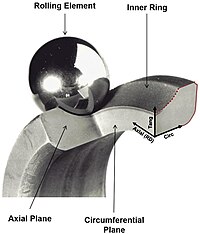
Photo from wikipedia
This paper presents a novel test rig to study the effect of fretting wear and of the contact surface evolution on the forced response of systems with dry friction contact.… Click to show full abstract
This paper presents a novel test rig to study the effect of fretting wear and of the contact surface evolution on the forced response of systems with dry friction contact. This rig allows simulating contacts similar to the type of contacts present between the shrouds at the blade tip. Several research groups have been studying how fretting wear affects the dynamic response of mechanical systems, developing numerical prediction tools that consider dry friction contact and nonlinearity. The aim of this work is to experimentally study the evolution of contact interfaces and how this evolution affects the system dynamics. Experimental results will aid to validate the numerical predictions. The test rig developed for this activity is made of a cantilever beam fixed at one end and with a friction contact at the free end. The contact couple is made of two replaceable specimens. The contact is loaded via a lifting mechanism through a screw with fine thread. Fretting wear test was performed at a constant frequency and force amplitude, exciting the beam with an electromagnetic shaker. To emphasize the change of the dynamic response, frequency sweeps were performed at various intervals during the wear test. The full range test with ‘changing preload’ due to progressing wear was performed until a full loss of contact. This paper describes the test rig design, intent, set-up, instrumentation, test plan and results. Results include the frequency response curves for unworn contact, wear profiles at multiple intervals and the effect of wear on the frequency response. Though energy dissipation per cycle is quite small, wear leads to material loss at the contact with a sufficiently large number of cumulative cycles and substantially affects the dynamic response. Results collected in this research activity are of particular importance to validate numerical tool that aim to simulate the dynamic behaviour of systems with dry friction contacts that undergo material loss caused by wear.